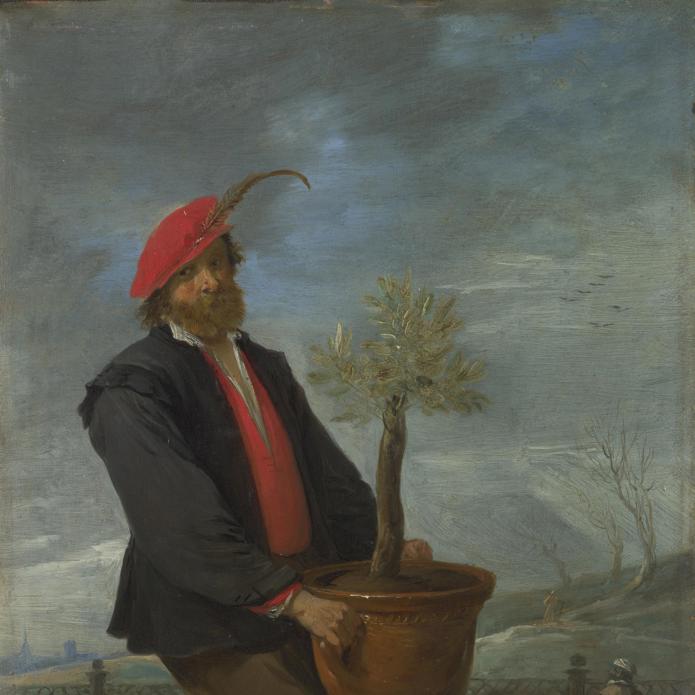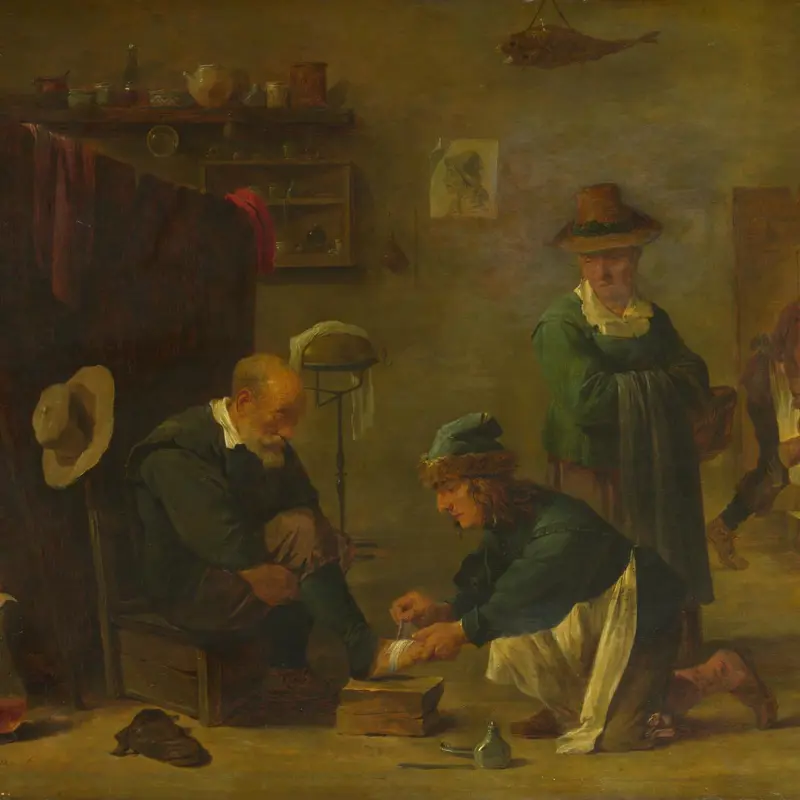David Teniers the Younger, 'Spring', about 1644
About the work
Overview
This is the first of a series of paintings by David Teniers in which the four seasons are given human form. Here, Spring is personified as a young gardener with a bushy beard, heaving a heavy pot containing a sapling. His step is jaunty and he has a gleam in his eye. His jacket looks new, and his red waistcoat and cap with the feather warm up the otherwise chilly background.
Overhead, wispy grey clouds bear the signs of April showers to come, and the trees in the background are leafless and windblown. A figure in a long gown walks up the hill – perhaps it is Winter making way for Spring.
Other gardeners dig the soil. They appear to have traced a pattern in the earth to follow when planting new trees, making a formal garden in the fashionable style set by French designers and followed with keen interest in Flanders.
Key facts
Details
- Full title
- Spring
- Artist
- David Teniers the Younger
- Artist dates
- 1610 - 1690
- Part of the series
- The Four Seasons
- Date made
- about 1644
- Medium and support
- oil on copper
- Dimensions
- 22.1 × 16.5 cm
- Inscription summary
- Signed
- Acquisition credit
- Bought, 1871
- Inventory number
- NG857
- Location
- Not on display
- Collection
- Main Collection
- Previous owners
Provenance
Additional information
Text extracted from the ‘Provenance’ section of the catalogue entry in Gregory Martin, ‘National Gallery Catalogues: The Flemish School: circa 1600–circa 1900’, London 1986; for further information, see the full catalogue entry.
Exhibition history
-
2011Winter Märchen: Winter-Darstellungen in der europäischen Kunst von Breugel bis BeuysKunsthistorisches Museum Wien18 October 2011 - 8 January 2012Kunsthaus Zürich10 February 2012 - 29 April 2012
Bibliography
-
1822British Institution, A Catalogue of Pictures of the Italian, Spanish, Flemish, and Dutch Schools: With which the Proprietors have Favoured the Institution, London 1822
-
1823J. Christie, A Catalogue of the Very Distinguished Collection of Italian, French, Flemish, Dutch and English Pictures… of George Watson Taylor, Esq., London, 13 June 1823 - 14 June 1823
-
1824W. Buchanan, Memoirs of Painting: With a Chronological History of the Importation of Pictures by the Great Masters into England Since the French Revolution, London 1824
-
1829
J. Smith, A Catalogue Raisonné of the Works of the Most Eminent Dutch, Flemish, and French Painters: In Which is Included a Short Biographical Notice of the Artists, with a Copious Description of Their Principal Pictures […], 9 vols, London 1829-1842
-
1844A.M. Jameson, Companion to the Most Celebrated Private Galleries of Art in London: Containing Accurate Catalogues, Arranged Alphabetically, for Immediate Reference, Each Preceded by an Historical & Critical Introduction […], London 1844
-
1854G.F. Waagen, Treasures of Art in Great Britain: Being and Account of the Chief Collections of Paintings, Drawings, Sculptures, Illuminated Mss. […], vol. 2, trans. E. Eastlake, London 1854
-
1970G. Martin, The Flemish School, circa 1600-circa 1900, London 1970
-
1983M. Levey, The Neglected National Gallery: An Exhibition of Paintings from the Lower Floor (exh. cat. The National Gallery, 20 April - 31 May 1983), London 1983
-
1986Martin, Gregory, National Gallery Catalogues: The Flemish School, circa 1600 - circa 1900, London 1986
-
1991M. Klinge, David Teniers de Jonge: Schilderijen, tekeningen (exh. cat. Koninklijk Museum voor Schone Kunsten, 11 May - 1 September 1991), Ghent 1991
-
2001
C. Baker and T. Henry, The National Gallery: Complete Illustrated Catalogue, London 2001
About this record
If you know more about this work or have spotted an error, please contact us. Please note that exhibition histories are listed from 2009 onwards. Bibliographies may not be complete; more comprehensive information is available in the National Gallery Library.
Images
About the series: The Four Seasons

Overview
This series of four small paintings is an allegory of the seasons: spring, summer, autumn and winter have been given human forms that embody the essence of each. Spring is a gardener carrying a tree to plant in a formal garden; Summer is a peasant tying up a sheaf of corn; Autumn is a drinker who raises a glass of wine; and Winter is an old man wearing a fur cap and mantle, warming himself near a brazier.
Strongly influenced early in his career by the Dutch artist Adriaen Brouwer, Teniers became the most famous painter of peasant life of his day, rivalling Brouwer’s rowdy, raunchy tavern scenes full of larger-than-life characters.
























